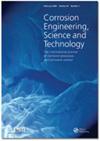废弃的海上钢铁基础设施长期腐蚀
IF 1.5
4区 材料科学
Q4 MATERIALS SCIENCE, MULTIDISCIPLINARY
Corrosion Engineering, Science and Technology
Pub Date : 2023-08-25
DOI:10.1080/1478422X.2023.2248710
引用次数: 0
摘要
摘要海上石油和天然气行业的一种常见做法是将废弃的退役管道和其他钢铁基础设施留在海底。关于长期环境和其他影响以及恢复可能性的决策需要估计可能的长期恶化率,包括腐蚀损失和凹坑深度。这些被认为是时间和环境条件的函数,包括海水温度、溶解氧浓度、盐度、海水速度、水污染、微生物活动、水深、钙质沉积和埋藏的影响,所有这些都是利用与长期暴露相关的既定物理化学行为来解释的。对海水中长达600年的暴露数据进行了审查。简要讨论了海洋腐蚀控制的剩余研究空白和未来展望。举例说明了对保护涂层和残余阴极保护的长期耐久性的影响,这两个领域都需要进一步研究。本文章由计算机程序翻译,如有差异,请以英文原文为准。
Long-term corrosion of abandoned offshore steel infrastructure
ABSTRACT A common practice in the offshore oil and gas (O&G) industry is to leave abandoned decommissioned pipelines and other steel infrastructure on the seafloor. Decisions about long-term environmental and other impacts and about the possibility of recovery require estimates of the likely long-term rate of deterioration, including corrosion loss and pit depth. These are considered as functions of time and environmental conditions including seawater temperature, dissolved oxygen concentration, salinity, seawater velocity, water pollution, microbiological activity, water depth, calcareous deposition and the effect of burial, all interpreted using established physico-chemical behaviour relevant for long-term exposures. Data for exposures up to some 600 years in seawaters are reviewed. Remaining research gaps and future perspectives of marine corrosion control are briefly discussed. Specific attention is given, by way of an example, to the influence on long-term durability of protective coatings and remnant cathodic protection, both areas in which further research is required.
求助全文
通过发布文献求助,成功后即可免费获取论文全文。
去求助
来源期刊

Corrosion Engineering, Science and Technology
工程技术-材料科学:综合
CiteScore
3.20
自引率
5.60%
发文量
58
审稿时长
3.4 months
期刊介绍:
Corrosion Engineering, Science and Technology provides broad international coverage of research and practice in corrosion processes and corrosion control. Peer-reviewed contributions address all aspects of corrosion engineering and corrosion science; there is strong emphasis on effective design and materials selection to combat corrosion and the journal carries failure case studies to further knowledge in these areas.
 求助内容:
求助内容: 应助结果提醒方式:
应助结果提醒方式:


